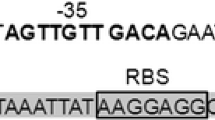Abstract
Objectives
Changes of bile salt tolerance, morphology and amount of bile acid within cells were studied to evaluate the exact effects of bile salt hydrolase (BSH) on bile salt tolerance of microorganism.
Results
The effect of BSHs on the bile salt tolerance of Lactococcus lactis was examined by expressing two BSHs (BSH1 and BSH2). Growth of L. lactis expressing BSH1 or BSH2 was better under bile salt stress compared to wild-type L. lactis. As indicated by transmission electron microscopy, bile acids released by the action of BSH induced the formation of micelles around the membrane surface of cells subject to conjugated bile salt stress. A similar micelle containing bile acid was observed in the cytoplasm by liquid chromatography-mass spectrometry. BSH1 produced fewer bile acid micelles in the cytoplasm and achieved better cell growth of L. lactis compared to BSH2.
Conclusions
Expression of BSH improved bile salt tolerance of L. lactis but excessive production by BSH of bile acid micelles in the cytoplasm inhibited cell growth.




Similar content being viewed by others
References
Ambalam P, Kondepudi KK, Nilsson I, Wadstrom T, Ljungh A (2012) Bile stimulates cell surface hydrophobicity, Congo red binding and biofilm formation of Lactobacillus strains. FEMS Microbiol Lett 333:10–19
Begley M, Sleator RD, Gahan CGM, Hill C (2005) Contribution of three bile-associated loci, bsh, pva, and btlB, to gastrointestinal persistence and bile tolerance of Listeria monocytogenes. Infect Immun 73:894–904
Begley M, Hill C, Gahan CG (2006) Bile salt hydrolase activity in probiotics. Appl Environ Microbiol 72:1729–1738
Bi J, Fang F, Lu SY, Du GC, Chen J (2013) New insight into the catalytic properties of bile salt hydrolase. J Mol Catal B-Enzym 96:46–51
Boggs JM (1987) Lipid intermolecular hydrogen bonding: influence on structural organization and membrane function. Biochim Biophys Acta 906:353–404
Dussurget O, Cabanes D, Dehoux P, Lecuit M, Buchrieser C et al (2002) Listeria monocytogenes bile salt hydrolase is a PrfA-regulated virulence factor involved in the intestinal and hepatic phases of listeriosis. Mol Microbiol 45:1095–1106
Fang F, Li Y, Bumann M, Raftis EJ, Casey PG, Cooney JC et al (2009) Allelic variation of bile salt hydrolase genes in Lactobacillus salivarius does not determine bile resistance levels. J Bacteriol 191:5743–5757
Gahan CGM, Hill C (2014) Listeria monocytogenes: survival and adaptation in the gastrointestinal tract. Front Cell Infect Microbiol 4:1–7
Hofmann M, Schumann C, Zimmer G, Henzel K, Locher U et al (2001) LUV’s lipid composition modulates diffusion of bile acids. Chem Phys Lipids 110:165–171
Hung DT, Zhu J, Sturtevant D, Mekalanos JJ (2006) Bile acids stimulate biofilm formation in Vibrio cholerae. Mol Microbiol 59:193–201
Islam K, Fukiya S, Hagio M, Fujii N, Ishizuka S et al (2011) Bile acid is a host factor that regulates the composition of the cecal microbiota in rats. Gastroenterology 141:1773–1781
Jarocki P, Podlesny M, Glibowski P, Targonski Z (2014) A new insight into the physiological role of bile salt hydrolase among intestinal bacteria from the Genus Bifidobacterium. PLoS ONE 9:e114379
Joyce SA, MacSharry J, Casey PG, Kinsella M, Murphy EF et al (2014) Regulation of host weight gain and lipid metabolism by bacterial bile acid modification in the gut. Proc Natl Acad Sci USA 111:7421–7426
Kurdi P, Kawanishi K, Mizutani K, Yokota A (2006) Mechanism of growth inhibition by free bile acids in lactobacilli and bifidobacteria. J Bacteriol 188:1979–1986
Pumbwe L, Skilbeck CA, Nakano V, Avila-Campos MJ, Piazza RMF et al (2007) Bile salts enhance bacterial co-aggregation, bacterial-intestinal epithelial cell adhesion, biofilm formation and antimicrobial resistance of Bacteroides fragilis. Microb Pathog 43:78–87
Wu CD, Zhang J, Wang M, Du GC, Chen J (2012) Lactobacillus casei combats acid stress by maintaining cell membrane functionality. J Ind Microbiol Biotechnol 39:1031–1039
Zhu Y, Zhang Y, Li Y (2009) Understanding the industrial application potential of lactic acid bacteria through genomics. Appl Microbiol Biotechnol 83:597–610
Acknowledgments
This work was financially supported by the National Natural Science Foundation of China (No. 31401638), the Natural Science Foundation of Jiangsu Province (BK20130132), and the 111 Project (111-2-06). We thank Professor Paul W. O’ Toole for kindly providing the strain of L. salivarius LMG14476.
Supporting information
Supplementary Table 1—Bacterial strains and plasmids used in this study.
Supplementary Table 2—Primers used in this study.
Author information
Authors and Affiliations
Corresponding author
Electronic supplementary material
Below is the link to the electronic supplementary material.
Rights and permissions
About this article
Cite this article
Bi, J., Liu, S., Du, G. et al. Bile salt tolerance of Lactococcus lactis is enhanced by expression of bile salt hydrolase thereby producing less bile acid in the cells. Biotechnol Lett 38, 659–665 (2016). https://doi.org/10.1007/s10529-015-2018-7
Received:
Accepted:
Published:
Issue Date:
DOI: https://doi.org/10.1007/s10529-015-2018-7




